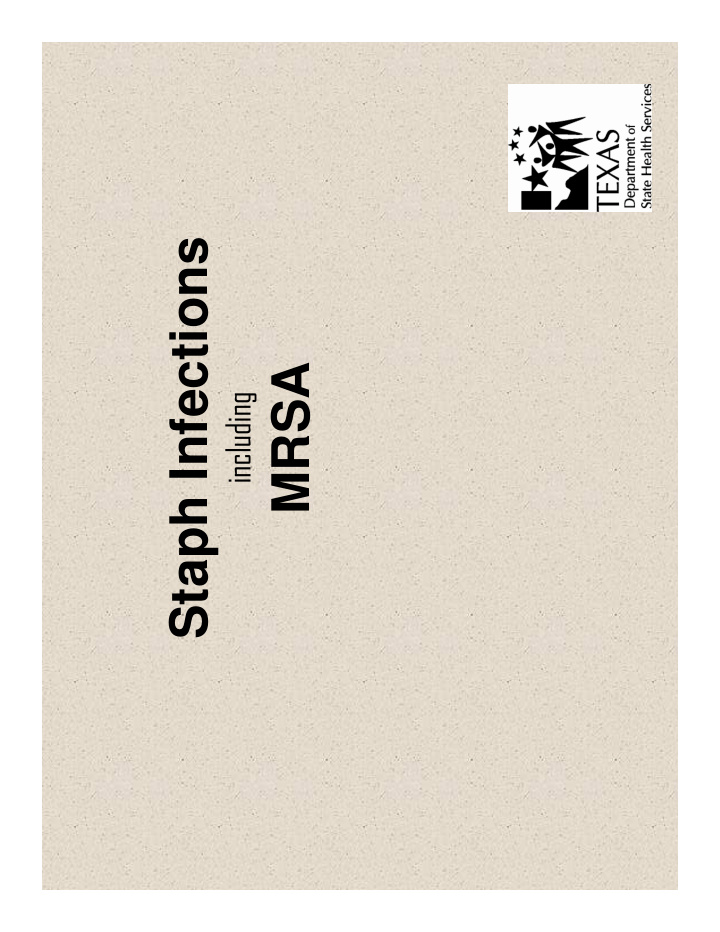



Staph Infections MRSA including
What is a Staph infection?
STAPH Staphylococcus aureus , often referred to simply as “staph,” are bacteria commonly carried on the skin or in the nose of healthy people.
SYMPTOMS OF STAPH INFECTIONS The symptoms of a staph infection depends on where the infection is. The staph bacteria can cause: • Boils – an abscess, bump, or swelling within the skin. Also called a furuncle.
• Cellulitis – a “flat” skin infection which can make the skin red, painful and warm but does not have pustules.
• Folliculitis – an infection of the hair follicles
• Impetigo – pustules (bulbous impetigo) or honey colored crusted lesions on the skin – May be caused by staph or other bacteria
In addition to skin infections, the staph bacteria can cause: • Bacteremia – a blood infection • Deep abscesses –an abscess that occurs below the skin surface • Endocarditis – an infection on the valves of the heart • Food poisoning – vomiting or diarrhea caused by a staph toxin • Lymphadenitis – an infection of a lymph gland, which causes it to be red, swollen and painful
• Lymphangitis – an infection of the lymph channels that drain to lymph glands, causing red streaks in the skin • Osteomyelitis – a bone infection • Paronychia – an infection of the skin folds of the nails • Scalded skin syndrome • Septic arthritis – an infection of a joint, like a hip or a knee • Styes – an infection of the glands on the eyelid • Toxic shock syndrome
The Staphylococcus aureus bacteria can also cause less common infections such as pneumonia, ear infections, and sinusitis.
To make a definitive diagnosis, and to confirm that staph is the bacteria causing the infection, a culture can be done. In the past, most serious staph bacterial infections were treated with a type of penicillin class agent such as oxacillin, penicillin, amoxicillin or a cephalosporin.
Over the past 50 years, treatment of these infections has become more difficult because staph bacteria have become resistant to various antimicrobial agents, including the commonly used penicillin class antibiotics.
One of those staph bacteria that is resistant to some antibiotics is called MRSA .
What is MRSA?
MRSA • MRSA stands for Methicillin-Resistant Staphylococcus aureus • MRSA are Staph aureus bacteria that have become resistant to this antibiotic.
People may be colonized or infected with staph. Colonization means that the staph is present in or on the body but is not causing illness. Infection means that the staph is present and is causing illness.
In general, healthy people are at low risk of getting sick with MRSA . Some risk factors include: • Recurrent skin diseases or open wounds • Long-term illness or long-term dialysis patient • Illicit injecting drug use • Surgery
• Been a patient in the hospital or other health care facility within the past year • Contact with other persons with MRSA infection • Recent antibiotic use • Live in crowded settings
HOW ARE THESE GERMS SPREAD? MRSA is transmitted primarily by contact with a person who has an infection or is colonized with the bacteria.
How can I protect myself from becoming infected?
• WASH YOUR HANDS • If no visible dirt, use alcohol-based hand sanitizer • Keep cuts and abrasions covered • Avoid contact with other people’s wounds • Avoid skin-to-skin contact with infected persons • Do not share personal items • Clean objects and other shared surfaces before you use them
HOW TO KEEP IT FROM SPREADING TO OTHERS • Keep infected areas covered • Follow doctor’s instructions • Wash hands • Put disposable waste in a separate trash bag and close tightly before throwing it out • Wear gloves
• Do not share personal items • Disinfect all non-clothing and non- disposable items • Wash linens and clothes that become soiled • Wash utensils and dishes in the usual manner • Avoid participating in contact sports • If you have a MRSA infection, be sure to tell any health care provider that you have this infection
And now, let’s look at what MRSA really looks like…
What is the most important thing to remember?
Wash your hands!!!
Acknowledgement The Infectious Disease Control Unit of the Department of State Health Services thanks Ginger Shields, RN Emergency Preparedness Specialist Texarkana-Bowie County Health Department for the creation and use of this presentation .
CDC Recommendations • - practicing good hygiene (e.g., keeping your hands clean by washing with soap and water or using an alcohol- based hand sanitizer and showering immediately after participating in exercise); • -avoiding sharing personal items (e.g., towels, razors) that come into contact with your bare skin; and using a barrier (e.g., clothing or a towel) between your skin and shared equipment such as weight-training benches . • experts believe that the MRSA Superbug evolved from a common Staph bacterium because of both the over prescribing of prescription antibiotics and the increased use by consumers of antibiotic cleaning sprays formulated for use in kitchens and baths.
Continued • . Many gyms provide cleaning sprays and paper towels for use by patrons. Spray the handles of cardio equipment both before and after use. If your health club does not provide cleaning products, tell them they should. • 2. Use a towel between you and the bench when lifting weights. • 3. Use a towel between you and hand weights when weight training, • 4. Carry an alcohol-based hand sanitizer and use it between machines when circuit training. • 5. Bring your own yoga mat. • 6. Ask if your gym washes and dries towels in hot water and hot dryers. If you suspect it doesn't, or they don't know, bring your own towels from home. • 7. Wash your own gym clothes at home in hot water and a hot dryer after every work-out.
Recommend
More recommend